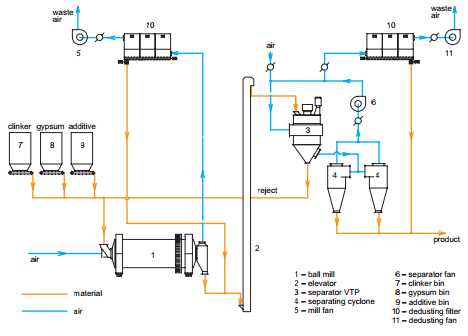Industry Reports
Choose vertical roller mill or ball mill in Cement grinding plant
Vertical roller mill has become the standard for grinding raw materials in the cement manufacturing process. but many cement producers are still favouring ball mill for cement manufacture when set up new integrated cement grinding plants. The industry has failed to fully adapt to this technological development, which offers significant energy savings, as it did with other technical developments such as the precalciner kiln or high efficiency coolers.

Both operation and maintenance
Operation of a ball mill is relatively simple, with no moving mechanical parts within the ball grinding mill itself. The ball mill system is tolerant to variations in both ball mill feed quality and quantity. By contrast, the vertical roller mills are a more complex piece of equipment with a sophisticated hydraulics system that operates the grinding rollers. The material bed between the grinding rollers and the grinding table is thin, and it is essential that the grinding rollers and grinding table do not come into contact. A variable bed of material will cause vibrations on the mill; this effect is somewhat reduced in vertical roller mills grinding kiln raw materials as the feed is larger than the cement mill feed. The moisture content on the kiln raw materials is also higher than the cement mill feed, which is generally dry. In order to reduce these vibration issues and adequately prepare the material, the rollers in the cement vertical roller mills have been modified. In some cases, grooved rollers are used to prepare to de-aerate the material in a low pressure zone prior to it passing into a high pressure grinding zone where the particles are fractured. In other cases, smaller rollers prior to the main rollers are used to achieve the same result.
In terms of ongoing operations, the grinding media in a ball mill has a much higher wear rate compared to that of the table and rollers in a vertical roller mill With a ball mill, it is important to monitor the performance through axial testing, in order to ensure that the media grading is correct and that there is a sufficient quantity of top-size media in the mill to sufficiently grind the mill feed materials. If this is not the case, ‘nibs’ (large, unground material) will collect at the end of the first chamber and block the slots of the mill diaphragm. However, topping up the mill with additional media is a simple task and most cement manufacturers will re-grade their cement mill media on an annual basis.
The other major repairs that take place on ball mills are to replace the liners and diaphragms and on a vertical roller mill to replace the grinding rollers and replace grinding table. The liners on a ball grinder mill generally last up to 5 years in the first chamber and as long as 8 years in the second chamber and therefore are infrequently changed. Diaphragm grinding plates will require changing more frequently, but certainly not on an annual basis. Whilst the wear parts on a vertical roller mill will not require changing on an annual basis, work will be required. This could be hard-facing the roller and table or reversing the roller segments. Eventually the wear parts will require replacement. Therefore the maintenance requirements of the vertical roller mills are higher than that of the ball mill. Overall, the maintenance costs are not dissimilar for both types of mills: while the wear rates for a ball mill are higher than for a vertical roller mill, the cost of the replacement parts is lower, and the opposite applies for the vertical roller mill– lower wear rate but higher replacement costs.

Product quality
One of the perceived difficulties with the vertical roller mill when they were first proposed as an alternative for cement grinding milling was the particle size distribution (PSD) of the product. Due to the high circulation factor in the mill and the high separation efficiency, vertical roller mills have the tendency to produce with a steep PSD curve resulting in cement that is dissimilar to that produced in a ball mill (a steep PSD cement results in high water demand cement). Again, the vertical roller mill manufacturers have adapted the conventional design of the raw mill vertical roller mill to address this issue.
Firstly, the grinding table profile curves upwards on the outside edges to retain a certain amount of material on the table. In addition, the vertical mills have an adjustable dam ring on the outside of the table, which has the same effect of retaining material on the table. In doing this, the material has a longer residence time on the table and a wider range of particles are produced. Other variables such as the grinding pressure, the mill airflow and the separator speed can also be tuned to change the PSD curve. Usually, a compromise is found between the PSD curve and energy consumption, as the above actions reduce the grinding efficiency and therefore increase the mill’s power consumption.



